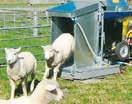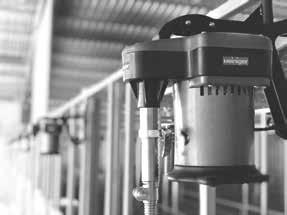






BE READY to be nimble. That’s the message to New Zealand primary exporters from international trade expert, company director and farmer Mike Petersen.
His advice follows the unprecedented shakedown in the geopolitical order, fuelled by significant policy changes by the US.
Petersen has joined the chorus of international trade experts who say NZ will inevitably get caught in the crossfire from trade wars between the US, China and others. He says our exporters will have to be ready at a moment’s notice to deal with what might happen. He says the good news is that our exporters have an excellent track record in dealing with changes and the agility to move quickly to keep trade flows going.
He says there is no question that the US is reasserting itself and lot of this is seen as quite reactionary and based on the ideal of ‘America first’.
“To be honest there would be a lot of people who would support that. Even if you look at the defence spending in Europe, I think the US has carried the defence umbrella for Europe over decades and in the US that is no longer considered acceptable. So

in some ways I can understand why they doing it, but the problem is that it is going to cause some chaos in the world and there will some measures taken by the US that will impact on us, even though they are not aimed at us directly,” he told Rural News
Petersen says the US alignment with Russia is as much about China as anything else. He says the dual importance of Chinese and US markets to NZ means our politicians and trade negotiators are going to have to
tread delicately and keep a foot in both camps.
He says while this whole situation may look concerning for farmers, they should not worry and keep focused on doing what they are good at and leave the diplomacy to the experts.
“We have very good people in place around international trade and geopolitics. But as a small country we don’t have ‘hard power’ in NZ like weapons. But we are very effective diplomatically with ‘soft power’ – the ability to nego-

tiate extremely effectively. My message to farmers is stay calm and don’t waste energy on what you can’t control,” he says.
On the domestic front Petersen says while many farmers feel they have a friendly government which is helping to boost confidence, they also need to be aware that the Government has a big picture agenda as well.
He says while some farmers are calling for NZ to walk out of the Paris Accord on climate change, he doesn’t
believe there is any chance of the Government doing this. He says NZ as a small country doesn’t have the luxury of walking out of major multilateral agreements and says if we did there is a high risk that the ‘big people’ in such agreements could take action to stop us entering their markets. Peterson says he doesn’t have concerns about climate change targets, saying it’s nothing that science and innovation can’t take care of.
“But I also believe that over the next 18 months, some farmers will potentially be frustrated by this present Government, especially around climate change,” he says.
Petersen says on the positive side, he’s really encouraged by the Government’s economic growth message and says that will be helpful to the primary sector, along with the Government’s emphasis on greater fiscal discipline.
As for what might happen at the Reserve Bank with the sudden departure of Adrian Orr, Petersen says any change will have minimal effect on the primary sector. He says the common view was that Orr’s decisions on inflation were wrong and the new governor will be more sensitive to concerns around this issue.
“I expect going forward the approach will be more moderate,” he says.


Free fertiliser – up to 200 kg of nitrogen/ha, every year. Energy rich, delicious grazing. Higher animal production.
White clover has a lot to give. But unless you choose carefully, there’s a risk this autumn neither you nor your animals will get the full benefit of this hero legume.
That’s because some seed mixes for pasture renewal are being sold with old, outdated or untested clover seed to keep costs down.
Given the big difference in performance between the latest clovers, and a common like Huia, which dates back to the 1950s, it’s worth checking exactly what your mix contains before sowing.
“This is really important,” says pasture specialist Graham Kerr, “as you could be missing out on a lot of value.”
Ryegrass dominates most seed mixes sold for pasture renewal, to the point where farmers often order seed by the name of their preferred ryegrass. A good example is you asking your supplier for a ‘Maxsyn mix’.
“White clover is the powerhouse of New Zealand pastures, and just like

ryegrasses, not all clovers are equal. Far from it, in some cases. That means we need to pay just as much attention to exactly which white clover we’re sowing as we do to particular ryegrasses.”
How can something that only makes up a small portion of a seed mix be so important?
“Just ask your animals!” Graham says. He’s only partly
joking – sheep, beef cattle and cows love clover, and thrive on it, so the more you have in your pastures, the happier they will be.
In summer, when ryegrass goes to seed and loses quality, lambs grazing clover will gain 100 grams/day more than those grazing grass, and dairy cows will produce 30% more milksolids/kg of dry matter.
Clover also fixes nitrogen out of the air, at around 25 kg N/ ha for every tonne of dry matter grown.
(In fact, before widespread uptake of synthetic nitrogen in the 1990s, NZ pastoral farming was almost entirely reliant on clover to fix nitrogen.)
So again, the more clover you grow, the more nitrogen enters your system, naturally,
sustainably and at no cost.
“This is a big win for the environment, too. Manufacturing nitrogen fertiliser, and transporting it to your farm, produces a lot more greenhouse gas emissions than having clover do the manufacturing for you, in your own paddocks.”
Research has shown pastures sown with modern white clovers produce up to 4.45.4 tonnes of extra dry matter/ ha, per year.
The key point here is ‘modern’. Plant breeders have made big gains in clover yield in recent years. All you have to do is compare the yield of Apex with Huia. “We’re talking about a difference in growth of approximately 36% over 12 months!” Graham says.
“In other words, all our clovers - Apex, Weka, Kotuku - are miles ahead. If you think about it in terms of animal genetics, growing Huia is like using a bull or a ram from the 1960s. Why would you do that when today’s sires are so much more productive?”
Modern clovers have also been bred for faster establishment, increased persistence, and better tolerance to clover root weevil.

1-10
12
12
12-14
15
SUDESH KISSUN
sudeshk@ruralnews.co.nz
FARMGATE MILK price could stay above $10/kgMS for two consecutive seasons, however, Fonterra is cautioning farmer shareholders to be wary.
After delivering a solid half-year result last week, Fonterra says geopolitical events outside the control of the co-operative remain a concern.
Chief executive Miles Hurrell says the co-op’s business spans the globe and the impact of tariffs remains to be seen.
TRADER 19
HEAD OFFICE
Lower Ground Floor, 29 Northcroft Street, Takapuna, Auckland 0622
Phone: 09-307 0399
Fax: 09-307 0122
POSTAL ADDRESS
PO Box 331100, Takapuna, Auckland 0740
Published by: Rural News Group
Printed by: Inkwise NZ Ltd
CONTACTS
Editorial: editor@ruralnews.co.nz
Advertising material: davef@ruralnews.co.nz
Rural News online: www.ruralnews.co.nz
Subscriptions: subsrndn@ruralnews.co.nz
He reminded farmers that “we live a volatile world”. Fonterra comes out with its 2025-26 season forecast milk price in late May.
DairyNZ says farmers might be in for a second season where the milk payout stays high, forecasting a $10.13/ kgMS payout for the new season, which starts June 1. With just over two months left to go this season, Fonterra is forecasting a milk price of $10/kgMS.
Another $10 milk price next season will break the trend of a quarter of a century, when high dairy payouts have been followed by a significant drop the following season.
Hurrell says he has seen commen-
Fonterra farmers may be in for a second season of a $10 milk price but geopolitical events could add uncertainty.
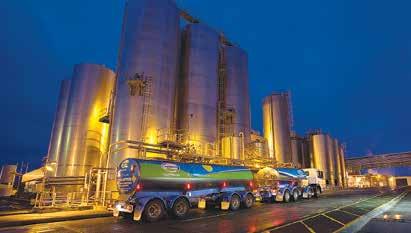
tary that “reflects another potential solid season”.
However, he says farmers must keep an eye on the geopolitical events.
“We deal in the international market, and we are living in a volatile world.”
Hurrell adds that Fonterra interim results – an 8% increase in profit after tax to $729 million and a 16% rise in operating profit to $1.1 billion – shows that the co-op is well positioned to face the geopolitical headwinds.
“We play in most markets globally, so what goes regarding tariffs will have an impact right across the board,” says Hurrell.
“We’ve done well in the last six
months, so we’re well set up to navigate the challenges. These things are outside our control, we just have to navigate accordingly.”
He says Fonterra is committed to delivering the highest sustainable farmgate milk price to farmers. For the current season, the forecast farmgate milk price range has been narrowed from $9.50-$10.50/kgMS to $9.70$10.30, with the midpoint holding at $10/kgMS.
“We’re seeing good demand for our quality products, and our teams have worked hard to optimise our product portfolio to capture value from the market conditions, leaving us well contracted for the season,” says Hurrell.
“We have also optimised the current season’s advance rate schedule to get cash to farmers sooner, underpinned by our balance sheet strength.”
In terms of milk flows, Fonterra’s forecast milk collections for the year are up 2.7% on this time last year to 1,510 million kgMS.
This follows favourable pasture growth across most of New Zealand earlier in the season, says Hurrell, noting many parts of the country are experiencing very dry conditions.
While predicting a payout of around $10.13/kgMS next season, DairyNZ says farm working expenses sit at $5.94/ kgMS which is reflected in the breakeven milk price of $8.57/kgMS.
DairyNZ head of economics Mark Storey said international supply and demand appear to be in good balance currently.
But he’s also giving farmers some cautionary advice.
“All forecasts made at the beginning of the season come with a strong caveat – a lot can and often does change throughout a season, as costs and returns to dairy are in many cases driven by international factors well outside the individual farmer’s control,” says Storey.
FONTERRA FARMERS are pleased with their co-operative’s interim results, says Co-operative Council chair John Stevenson.
He told Rural News that the results give farmers confidence.
“A fully imputed interim dividend of 22 cents per share evidences our co-op’s strong focus on return on capital,” he says.
“Maintaining the forecast farmgate
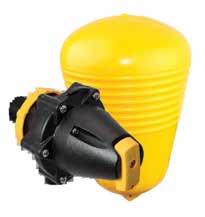
•Ideal for Cattle Troughs
Flow
milk price midpoint for the current season at $10/kgMS with a narrowed range will give farmers confidence.
“Both a high milk price and solid earnings are a great outcome for farmer shareholders and council acknowledges the efforts by Miles Hurrell and his team.”
Fonterra chief executive Miles Hurrell says it’s pleasing to be able to deliver these results for farmer share-
holders and unit holders.
“We’re focusing on driving value which includes delivering strong financial performance while achieving the highest sustainable farmgate milk price,” says Hurrell.
“At the same time, we’re looking ahead as we implement our strategy and continue to invest for the future. We have commenced projects to unlock manufacturing pro-

Mount
to Clean


for Small/Low Demand Troughs
Flow
duction capacity for our Ingredients and Foodservice channels, with site works now underway at Studholme for high-value protein capacity and at Edendale for a new UHT cream plant.
“We’re also continuing to invest to future proof our operations and supply chain network, with work underway on a new Whareroa coolstore and plans for decarbonisation projects.”

Water Mount


Flow
in Check-Valve •Ideal for Compartment Troughs/Tanks
Mount
to Clean


ASB’S NEW head of food and fibre, Kristen Ashby, believes that there’s “heaps of opportunity” in the agriculture sector.
Ashby took over the role in February, joining the bank after a stint at Fonterra as its director of capital strategy.
Prior to that, she had been a chartered accountant and has also held roles with organisations like T& G Global and Goodman Fielder.
“I’ve only been in the role for six weeks, I’m looking forward to getting out and I’ve already been meeting some farmers and hearing what they’re thinking about,” Ashby told Rural News
She says there are several challenges facing the sector now, some are controllable and others
“I’ve only been in the role for six weeks, I’m looking forward to getting out and I’ve already been meeting some farmers and hearing what they’re thinking about.”
more uncontrollable.
“Businesses always have a range of challenges and opportunities, and rural banking is no different to that,” she says.
Among the main challenges for rural banking customers are weather conditions, commodity prices, and succession planning.
Ashby says that the

challenge of weather conditions is not something that is new to rural customers.
“At the moment, we’ve got drought conditions up in Northland, drought conditions in parts of the
Waikato, but then Canterbury’s been very wet and that’s affecting some of the cereal crops,” she says.
She says that one of ASB’s roles is to help farmers bank through
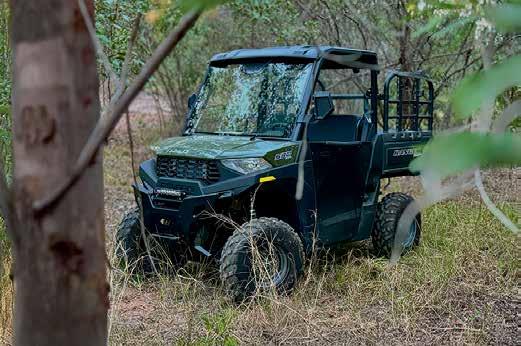
the cycles. “We know that all commodities –and rural is no different – go through cycles and there’s ups and downs. Everyone has that and we really want to make sure we’re building our farm-
ers’ trust that we’ll back them through the highs and the lows,” Ashby says.
At the same time, wealth transfer and succession planning are significant issues for
farming customers.
“We’ve got farmers who’ve been on the land for quite some time, they’re thinking about their next move, they might not be capable of or willing to farm anymore, but they might not have children or family members who want to come in and take over the farm because young people have lots of different opportunities these days, and so we’re talking to a lot of customers about wealth transfer and succession planning and how to do that in a sustainable and positive way,” Ashby says.
“Those are some of the challenges but there is so much opportunity at the moment,” she adds. “I think there’s more and more in the sector every week.”




NEW ZEALAND’S red meat sector is looking at exporting more than sheepmeat products to India when a comprehensive free trade agreement is secured between the two countries.
With negotiations formally launched in New Delhi last week, sheep farmers and processors are excited by the prospect of an FTA unlocking an important market that carries a 30% tariff on sheepmeat.
Meat Industry Association chair Nathan Guy, who was part of a business delegation to New Delhi led by Prime Minister Christopher Luxon, is excited about the prospect of an FTA with India.
“A robust and productive trade relationship between New Zealand and India provides many opportunities,” says Guy.
“New Zealand has a great reputation as a trusted, reliable, and responsible trading partner. Like many developing countries around the world, India has experienced significant eco-
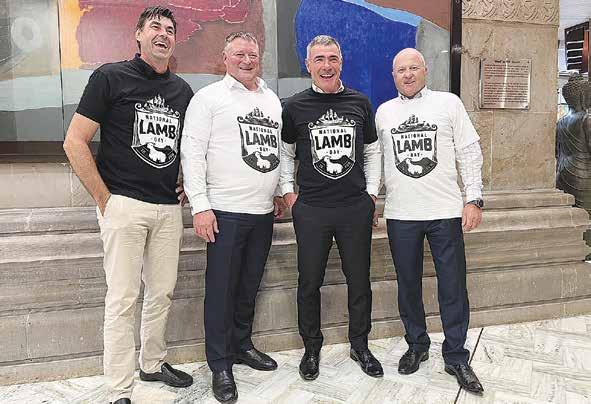
nomic growth over recent decades and has a growing middle class with a focus on health and wellness, who are seeking high quality and nutritious animal protein options.”
Guy says India is an expanding and dynamic economy with real potential for opportunities for New Zealand.
“As well as sheepmeat products, the wide range of by-products, known as the fifth quarter, provide
significant opportunities for New Zealand, with offal exports boosted through the rise of the pet food industry and the strengthening demand for serum exports.
“India plays a key role in the pharmaceutical industry, manufacturing and exporting products such as vaccines to other countries. New Zealand’s fifth quarter products are sought after because of our disease-free status.”
B+LNZ chair Kate
Acland points out that a comprehensive, commercially meaningful FTA could be one of the most important trade agreements secured since China.
“An FTA with India would unlock an important market that had previously been somewhat closed to us due to the 30 percent tariff currently on sheepmeat.
“There is immense potential of strengthening trade ties with India,
which is set to become the world’s third-largest economy within the next five years.
“By 2030, India is projected to have an additional 140 million middle-class households and 21 million high-income households.
“With rising demand for high-quality, nutritious sheepmeat and domestic production unable to meet this demand, New Zealand is well-placed to supply pre-
A GROUP representing the country’s business leaders says that a comprehensive FTA with India should be concluded as soon as possible.
The NZ International Business Forum (NZIBF) says it believes there’s “enormous value to be gained from comprehensive FTA with India”.
NZIBF chair and NZ Winegrowers chief executive Philip Gregan wants a deal as soon as possible.
“While this marks the start of a renewed negotiating process between our two countries, there is also a need to accelerate the work underway to build the relationship with India across all sectors,” says Gregan.
“This will assist in establishing a strong basis for a high quality and ambitious agreement, including in sectors previously considered off-limits.
“We should be seeking to address as many issues in the economic relationship as possible, including tariffs and non-tariff barriers in all sectors of interest, along with a body of effective trade rules reflecting the progress we have both made in other agreements.
“The difficult state of the world trade environment points to the need to conclude these negotiations as soon as possible and we welcome the two governments’ clear commitment to that end,” he says.
mium products to this growing market.”
Beyond sheepmeat, India offers significant market opportunities for New Zealand co-products, including pharmaceuticals, wool, and pet food.
“A comprehensive and commercially meaningful FTA must deliver tariff liberalisation for these products and reduce non-tariff barriers to ensure increased access for New Zealand exporters,” says Acland. A sticking point in any FTA with India would be dairy. As the world’s largest producer of milk, most of which is consumed by the farmer and his family, the Indian Government will be wary of a potential backlash by powerful farmer groups.

SHAMUBEEL Eaqub is warning that inequality between countries has fallen markedly over the past 200 years but inequality and political polarisation within countries was on the rise.
In a wide-ranging speech, covering both
domestic and international pressures and uncertainties, delivered at the DairyNZ Peoples Expo in Ashburton this month, Eaqub noted that data on household spending in New Zealand showed a sharp recent decline in the percentage of households buying fruit and vegetables.
Over the last several
decades, 80 to 90% of households would normally buy fruit and vegetable in each week but in 2023, that dropped to just 60%.
“Forty percent of households did not buy fruit and vegetables in each week in 2023. The expansion of poverty that we have seen in New Zealand over the course
of the last few years is unprecedented.
“This is not to make you feel guilty, it’s for you to understand that this might be your workers, it might be your supplier. It might be people in your community.
“And for a country that prides itself on being a food producer, it’s a pretty damn shame that
we have people who are hungry and living without good food.”
Internationally, Eaqub said persistent inequality has led to current global tensions.
“Whether it’s Brexit in Europe, whether it’s the rise of the far right in Europe, whether it is the rise of Trump in America, all of these things are


part and parcel of this discontent within societies, and I don’t think we should assume these things are aberrations.”
Eaqub said that “chainsaw Musk” was taking to America’s Federal Government but the bigger issue was not the firing of people.
“The bigger issue is that their judiciary is under attack. If the rule of law is under attack, that is the fundamental premise of a strong economy.
“Some of the changes that we’re seeing now there might be really quite fundamental in terms of very fabric of our economy.
“We’re probably going to see more risks more often than have been the case. So, we need to really invest in our own people and own businesses to make sure they’re resil-
ient, because when those external things happen, we find solace in the stability that we have with them.”
New Zealand has benefited massively from a world of consistent rules but uncertainty would rise in coming decades, he said.
Trade routes were at risk, and we could see more instances like the recent Chinese naval activity in the Tasman, he says. Artificial Intelligence (AI) was already becoming more politicised.
“Imagine there is an AI product that’s coming out of China. Do you really think the Americans would want to give us security cover if we’re using their technology?
“The answer is no. The answer is we’re not going to have independence in terms of what technology we use on our farms.”
YOUNG MAORI farmers from Northland, the King Country and Tairawhiti are the finalists in this year’s Ahuwhenua Competition for the top Maori sheep and beef farmer. They are Coby Warmington, Grace Watson and Puhirere Tau.
The award was inaugurated in 2012 and is designed to recognise up and coming young Maori in the pastoral and horticulture sectors. Since its inception, the competition has proved to be popular and has attracted high quality entrants. The finalists this year were selected from several entrants from around the country.
Warmington (29) is the farm manager at Waima Topu Beef Ltd, a bull beef finishing farm in Waima, Northland. The farm has 385 effective hectares of mostly rolling hill country. Warmington lives on-farm with partner Holly and their four children.
Watson (24) is a shepherd general on Puketitiri Station at Te Kuiti owned by Verry Farming running 3,500 breeding ewes and 1,200 replacements. She grew up on her parent’s dairy farm at Rerewhakaaitu just south of Rotorua.
For Tau (27), it’s a second attempt for glory in the competition. Tau is head shepherd at Puatai Station, a bull finishing block on the East Coast, where he plays a crucial role in managing a 650ha farm. – Peter Burke
IRISH MINISTER of State for Rural Communities says his country and New Zealand face very similar challenges on a range of issues related to agriculture, including climate change, biodiversity and rural depopulation.
Jerry Buttimer was in NZ recently as part of an annual venture by the Irish government to send their ministers to over 40 countries with strong Irish connections, to be part of local St Patrick’s day celebrations. It is said that one in six New Zealanders are of Irish heritage.
While in NZ, Buttimer held talks with government ministers and officials, businesspeople and those associated with arts and culture. He also had special meetings with
HOSTING JERRY Buttimer during his eight-day visit was NZ Minister for Rural Communities Mark Patterson who took him to the rural games in Palmerston North –an event which saw the Irish minister held aloft by one of the ‘strong men’ competitors at the event.
On the serious side, Patterson says Ireland and NZ have many issues in common, not the least of which is greenhouse gas emissions.
“The point of the discussions was to try to learn more about what each other is doing. Of course, we are jointly investing with Ireland in the greenhouse gas research centre and there are lot of things happening between the two countries,” he says.
Patterson says while it’s true that there has been some decline in rural communities in NZ, it is not all negative. He says there are moves to make sure there are good services in rural areas, which will make it attractive for people to live there. He says Ireland and NZ have very strong cultural ties which is helping to develop a strong relationship.
“We are both small countries that are being dominated by a power play at the moment; we are both grappling in real time how to respond to that,” he says.
various Maori representatives and chaired a hui on Maori business.
Buttimer told Rural

produce and profitability in a fast-changing world.
and the way they farm,” he says.
News that a big issue is how farmers and farming communities can maintain the quality of their
“Coming to NZ and seeing how you are dealing with things such as rural depopulation and succession planning has been very helpful. After all, we as two small counties have shared values when it comes to agriculture and our farmers are proud of the quality of the produce they produce
Buttimer says he admires the way NZ is dealing with succession planning and the encouragement given to young people to make a career in the agri sector. He says there is already a great deal of cooperation between the two countries, which is greatly beneficial to both nations.
He also made a pitch for NZ to look closely at the investment opportunities Ireland has to offer, pointing out it is at the heart of Europe and the only English-speaking nation in the European Union. He says Ireland is also interested in NZ’s initiatives to preserve the Maori language and way the Maori economy has been fostered and grown.
“Coming to NZ and seeing how you are dealing with things such as rural depopulation and succession planning has been very helpful.”
This is Buttimer’s second visit to NZ. He first came here as a tourist in 2007 and has many special friends here. As well as visiting Irish societies in Wellington, Christchurch and Auckland, Buttimer took part in a special St Patrick day luncheon at Parliament hosted by speaker Gerry Brownlee, who has Irish connections.




MORE THAN 2,000 farmers in droughtstricken areas of the country are now seeking support from the Rural Support Trust (RST).
According to the national chair of the trust, Michelle Ruddell, they are expecting more calls for help as the drought continues.
She says all fourteen regions where the RST is based are getting calls through the 0800 number. Drought has been declared in all western areas of the North Island, including the Manawatu, but also the top of the South Island. The declarations have enabled farmers and growers to access help through the RST and other agencies.
“It’s affecting farmers differently in different areas,” Ruddell told Rural News.
“For example, in Northland there is a shortage of stock water, but it’s been possible to truck in feed to farmers PETER BURKE


World’s most powerful variable speed clipper is here!

MAKE DIRTY JOBS EASY THIS SEASON
■ Ideal for shearing sheep, alpacas, goats and cow tail.
■ Variable speed from 2600-3500rpm.
■ Latest brushless motor technology means minimal heat build up
■ 1400gms means 100-200gms lighter than standard handpiece
■ At 2800rpm the 12v lithium battery will trim up to 400-500 cows tails or crutch 300-400 sheep
■ We customise cables for lifestyle shearers.
GET YOUR REPAIRS & SERVICE DONE ASAP!
View in action go to www.handypiece.co.nz Freephone 0800 474 327 email: dave@handypiece.co.nz


there. But in other parts of the country, feed is running out and supplements that would normally be saved for winter are now having to be fed out. We know the drought has been very bad in Taranaki and we are now hearing reports from some areas of the West Coast of the South Island which are also suffering from the dry,” says Ruddell.
Help for farmers and growers is coming via a multi-agency effort including Beef+Lamb NZ, DairyNZ, FMG, HortNZ, Federated Farmers and the Ministry for Primary Industries (MPI) as well as the RST.
Ruddell says in Taranaki there has been a good uptake by farmers of the dry workshops being arranged by DairyNZ. She says the RST and other organisations have been running special events and functions to get farmers and
THE CHALLENGE for many farmers is what comes when the rain starts to fall and the drought starts to break, according to Ballance Agri Nutrients science strategy manager Warwick Catto.
He’s been travelling around the country, noting the very dry places, and says most people can deal with a summer drought. But he warns there are challenges ahead unless there is rain soon.
“The autumn droughts are the most challenging because the growing window is shrinking, more so in some areas than others, and there is less time to build covers for winter feed and autumn pasture. And there is no magic answer,” he says.
The use of nitrogen fertiliser is normally seen as one of the main ways to get pasture to grow quickly, but Catto says farmers should remember fertiliser is a growth accelerator so they need to be cautious when applying it when a drought ends. He says the key thing is, when you get rain, the plants are trying to recover first and so there will be plenty of nutrients and nitrogen there to support the initial growth that will come.
“I guess one of the key messages is that you don’t need to rush out and put nitrogen on the day or next day after it
growers off their properties to meet others in the same situation, to share their problems and hopefully come up with solutions.
“The aim is to assure people that they are not alone, and that help is available,” she says.
But Ruddell says the situation is likely to get worse as no rain is forecast for the foreseeable future.
One of the agencies involved in helping drought affected farmers
rains. You have several weeks before you need to put it on, so there is no urgent rush and fear that you have missed the bus by not putting N on straight away,” he says.
Catto also especially warns against putting nitrogen on new pasture just after it rains saying there is a risk of nitrate poisoning which will damage the pasture. He adds that cool and cloudy days are when there is the highest risk.
The other key message from Catto is for farmers to divide their pastures into three groups. Those that will recover quickly, those they will do so but take little longer, and those that are slow and may never recover.
“The obvious thing is don’t spend any money on those that won’t recover from a nutrient perspective.
“Put your investment in those that will recover, because that is where you’ll get your best return,” he says
The other point Catto makes is that farmers don’t need to rush out and get a soil test after a drought. He says a test taken a year or two ago should be an adequate indicator of fertility. Overall, Catto says farmers should err on the side of caution and not use N until the pasture starts to pick up and can benefit from the extra fertiliser.
is MPI’s On Farm Support team led by Dr John Roche. He’s been around the country for the past few weeks and has seen the situation for himself.
He says having driven through Taranaki, he’s seen how bad the situation is. He says at this stage animals are being fed, but there are concerns about what might happen if the dry conditions continue.
“I think the daytime temperatures are still pretty high, but the night-
time temperatures have fallen, and we are seeing cooler nights and dews in the morning. We have also got low soil moisture levels right up and down the west coast of the North Island and there are other regions that we are monitoring closely,” he says.
Roche says MPI is in regular touch with local Rural Advisory Groups to make sure they don’t inadvertently miss an area that is in trouble. He says in some areas pas-
THE MANAWATU is one of the latest places to be declared a drought region.
Horizons Regional Council science and regulation manager Dr Lizzie Daly says the declaration follows months of low rainfall levels across most of the region. She says five of the seven districts have received below average or low levels of rainfall compared to what would be expected for this time of year.
“The lack of significant rainfall means waterways are at or nearing the point where water abstraction needs to be carefully managed. Low rainfall levels have a knock-on effect, causing low river flow which leads to reduced recharge of groundwater reservoirs.
“These conditions mean many of our monitoring sites have been moving in and out of low flow water restrictions over the past few months,” she says.
Daly says consent holders should continue to regularly check Horizons’ EnviroData and WaterMatters resources to stay up to date with restrictions.
ture covers are low but there is a green tinge there implying a ‘green drought’.
AN INITIATIVE by the Ministry for Primary Industries (MPI) to connect farmers with scientists is taking off judging by the response at recent regional field days.
MPI’s new Science for Farmers stand drew a lot of interest at this month’s Central District Field Days.
The aim was replicate, albeit on a smaller scale, the golden era of the 1960’s and 70’s when thousands of farmers flocked to the annual Ruakura Farmers conference with its talks and farm tours and the chance to meet face to face with scientists.
The numbers of farmers at the Science for Farmers site were understandably modest compared with what happened 50 years ago but it is seen as start to establish a forum where farmers and scientists can meet one on one to talk

through issues. The idea of Science For Farmers came about when Dr John Roche, MPI’s director of On Farm Support, and MPI director general Ray Smith visited Ireland just over a year ago.
John Roche, who’s Irish, attended what’s called the Irish Plough-
ing Championships but in fact is a huge agricultural event similar to, but bigger than, our National Fieldays and attracts more than 300,000 visitors over three days.
At this event Roche and Smith visited the site of the Irish collective science organisation
called Teagasc, which is similar to what our MAF looked like 40 years ago, where scientists, educators, advisors and policy makers are all part of the same organisation.
“What we saw at the Teagasc site was huge numbers of farmers talking to scientists, asking
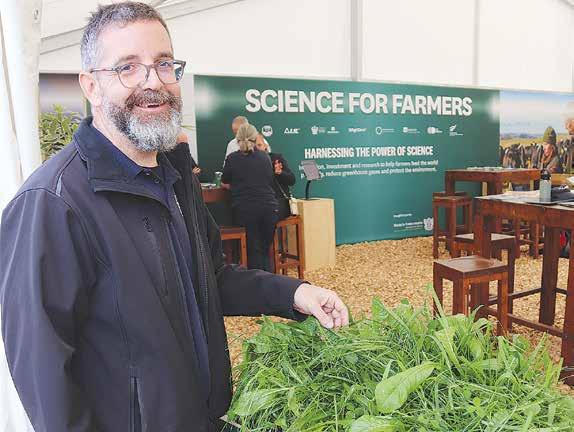
Whenua Haumanu project on regenerative agriculture.
Dr Andrew Cartmill is leading the work on pastures which involves comparing contemporary perennial ryegrass and white clover pastures with the more hyper diverse pastures to see how these perform.
Cartmill says they are basically looking at everything from the soil right through to animal performance but points out that it is a pasturebased study.
“From this and the previous field days, farmers are really interested on how the pasture looks; they are keen to know if it performs as well as what they are hearing from other sources. It’s our job to find out what does and doesn’t perform because we are a neutral party in this seven-year
them questions and in turn the scientists were getting feedback about the issues that farmers would like to learn more about,” Roche told Rural News
Back in NZ, Roche says as he travelled around the country, the message he got from farmers was they hardly ever had the opportunity to meet face to face with scientists.
“Interestingly when I talked to scientists, they told me they hardly ever see farmers,” he says.
Armed with that feedback, Roche and his team approached several of the science providers such as Massey University, Ag Research and LIC and hence was born the concept of Science For Farmers, which now takes the form of a special stand at regional field days and will also be present at National Fieldays.
ON THE CD Field Days stand were representatives of the many science providers and MPI. The site was set up to make dialogue between farmers and scientists easy. The display boards are interactive and the people on the stand engaging.
John Roche, MPI, says they have been talking to farmers about greenhouse gas emissions and the technology and ways available to mitigate impacts on farm. He says genetics is another popular talking point as is new research into diverse pasture species.
“We have been having some great conversations because our people are talking to farmers about things that nobody has talked about with them in the past,” he says.
Roche says they have been making farmers aware of the fact that if they breed animals for efficiency, that will lead to a lower greenhouse gas footprint. He says the animal health plan is something that farmers often don’t see as a priority.
“But a healthy herd produces more milk, needs less feed for maintenance and produces lower somatic cell counts and other animal health matters,” he says.
Roche says based on the feedback from the central district and other field days, MPI and its partners will have an even bigger display at the June National Fieldays.

study,” he says. Cartmill says they started out trialing some 20 different grass species and have now refined this down to just seven. He says the animals seem to like the diverse pasture and appear to be performing very well in it. But he points out the study is still in its early stages and more work is needed to get a clear picture of the benefits of diverse pastures and also the cost of such benefits.
A 100-YEAR-OLD Canadian irrigation district has taken inspiration from Canterbury irrigation company Central Plains Water’s success in converting from an open race irrigation system to a gravity-fed piped system.
Raymond Irrigation District (RID) operates an irrigation system covering some 20,240ha of farmland in Alberta, Canada. The company supplies more than 300 users including municipalities, farms, and habitat areas.
RID is transitioning from open water races to pipelines and is exploring gravity pressure systems like that used by Central Plains Water Ltd (CPW), which is what brought the Canadians to Canterbury in November 2024.
“We have a project to take advantage of the drop from our intake in the foothills to bring a gravity pressure pipeline to our district,” said RID general manager Jason Miller.
“But that will generate too much pressure, so we must install pres-

sure reducing valves to manage flow and pressure. The only place in the world we had heard of where someone else was operating a system using these valves was Central Plains Water. So, we reached out to see if we could come over to learn from their knowledge and experience.”
Miller said the visit was a success. The lessons from CPW’s experience will mean RID can avoid some of the risks and challenges of gravity pressure schemes and maximise their advan-
HORTICULTURE NEW Zealand has welcomed the Hawke’s Bay Regional Council’s decision to advance plans for a new water storage facility on the Heretaunga Plains.
The council is now entering a full feasibility phase for a medium-sized 27-million-cubic-metre water storage facility at Whanawhana, aimed at supporting the region’s people, businesses and environment.
The Heretaunga Plains, home to most of the region’s population, includes Napier and Hastings. Formed over 250,000 years ago from alluvial and coastal deposits, alternating levels of coarse and fine sediments allow for the formation of aquifers which provides 64% of the Heretaunga Plains water needs, with a further 35% provided directly by streams and rivers.
Council chair Hinewai Ormsby said the future of Hawke’s Bay’s economy depended upon water security and the ability to access new freshwater supplies. However, this was becoming a challenge as the climate changes, representing increasing risk
tages. But, he added, they learned a whole lot more, and it’s already resulting in changes to the way RID plans for the long term.
“One of the great things we learned from CPW was the importance of long-term planning. They (CPW) have a great long-term strategic plan and that was another really big takeaway for us that we need to work on.
“There’s no doubt that Central Plains Water is at the front of the game in terms of developing this sort of irrigation system.
They are showing the way on issues such as improved water management, cutting down on energy consumption, and expanding agricultural outcomes.
“One of the advantages of the gravity pressure pipeline system is it removes the need for large, carbon-producing, engines and pumps. By taking up a system similar to what CPWL has done we will save a significant amount of greenhouse gas emissions and, more important, we’ll save significant amounts
of water. That will enable us to use water in more ways and just be more efficient, demonstrating good stewardship of the water and the land.”
RID chair John McKee echoed this sentiment. “We’ve been around for 100 years but we were tending to plan ahead in small bites at a time. What we learned from CPW’s 100-year plan was how essential it was to plan for a long-term future. That includes things you Kiwis are already doing, such as thinking about our social
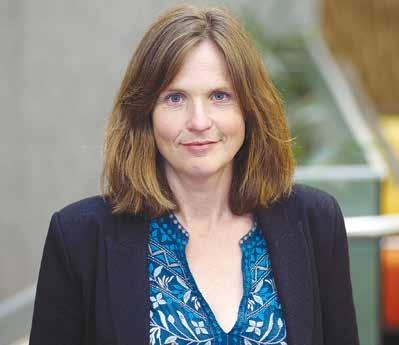
to the people of Hawke’s Bay and its environment and economy.
“As part of our ongoing Water Security Programme, HBRC is focused on how we can better protect our waterways while supporting the future of our economy. There is now greater appreciation of the importance of resilience and the role
of infrastructure in responding to climate change.
“Well-developed, responsible water storage projects will need to be part of our future, alongside continued discipline in demand efficiency and other potential supply initiatives.”
HortNZ general manager for strategy and policy Michelle Sands says
CENTRAL PLAINS Water chief executive Susan Goodfellow said the visit by RID was beneficial for CPW team as well, especially the discussions on how water needs to be managed for a sustainable future.
“Water supply is certainly now a global issue,” she said, “and the exchange of ideas and information with RID was extremely important in that regard. There has been a huge focus on emissions in terms of challenges to the global environment, but I think water has not had enough attention and this will have to change.
“The challenge we share with RID is how we can minimise water waste and maximise and diversify the range of uses water can be put to. This is not only an economic advantage, it is a community and social good, and it demands the sort of long-term planning we are proud of incorporating into the way CPWL operates. It was great to see how RID was very much in agreement along these lines and both companies benefited from this exchange of ideas. If we and RID are going to be around for another 100 years, we cannot think short term. Innovative, forward thinking across decades will be essential to our shared futures.”
licence to operate, water availability, energy efficiency, making the most of the water we get, environmental issues and so on.”
McKee said RID was also interested in the consenting and water permits environment and how CPW and its farmers dealt with that.
“We are not operat-
the announcement is welcome news for growers and households alike, as access to reliable irrigation water is also essential for a thriving horticultural sector.
She explains that the Heretaunga Plains is one of New Zealand’s most important food-producing regions as its soils and climate enable a high degree of crop diversity.
“A secure and sustainable water supply is crucial to maintaining this productivity. HortNZ acknowledges that the underlying aquifer, which supplies much of the water for horticulture, must be carefully managed to protect the health of spring-fed rivers and streams.
“The council’s recognition of the need for a secure freshwater supply for growers is a significant step forward. The new water storage facility will help safeguard the industry’s future, create resilience to climate change and support continued economic growth and job creation in the region.”
The proposed facility would be located on a small tributary off the Ngaruroro River. Excess water would
ing in the same regulatory environment in Canada but it’s coming, and we need to be prepared for it. We see CPW as a sort of ‘canary in the coalmine’ that will give us advance warning of where the world is going with water management tied into sustainability, and the ongoing social right to operate.”
be harvested when abundant and could be used to replenish rivers and aquifers during dry spells or times of high demand.
This would allow residentsincluding growers - to access water when they need it, while improving the overall health of rivers and streams and enabling strong, sustainable growth in the region.
Ormsby said the facility would be part of a multi-faceted approach to maximising efficiency and water consumption while also unlocking significant productivity gains.
She adds that the new governance entity will bring together iwi and mana whenua partners, irrigators, representatives of commercial and municipal water users and community stakeholders to lead the project with a strong development focus.
Horticultural crops grown on the Heretaunga Plains are critical to both export and domestic markets. The plains are particularly vital to New Zealand’s apple industry, valued at over $1 billion in revenue, with around 65% of production based in Hawke’s Bay.
AN INNOVATIVE idea for transforming mechanically deboned meat (MDM) into a meat flake for seasoning has taken top honours in the Meat Industry Association’s (MIA) first-ever Dragon’s Den competition.
Renyu Zhang, a senior scientist with AgResearch, won the inaugural contest, which challenged Kiwis to develop groundbreaking ideas to advance New Zealand’s red meat processing industry.
A total of 42 entries were received, with Zhang beating four other finalists to secure a prize of up to $10,000 to develop a business case and progress the idea into a research project.
Zhang’s ‘unamification’ of MDM proposal outlined a novel process to transform lower-value MDM into a meat flake with high unami (savoury

flavour) which would be stable at room temperature and have uses as a protein enhancer and snack food.
Sirma Karapeeva, chief executive of the Meat Industry Association, said the high calibre of entries made selecting the five
finalists and ultimately the winner a challenging task.
“The competition recognised that many people
have transformative ideas but may lack the resources to bring them to life.
“We sought bold,
innovative concepts in meat industry research and development that align with the Government’s ambitious goal of doubling export value.
“All the finalists deserved credit, however, Zhang’s idea stood out both for the innovative process proposed and the opportunities for global interest in such a product.”
Zhang said he was pleased to win the competition and get an opportunity to take the project to the next stage.
“I’m honoured to win this inaugural Dragon’s Den event, and grateful to MIA for this opportunity,” he said.
“We have exciting opportunities to turn low-value streams from the meat industry into high-value, uniquely Kiwi products that can strengthen our global
presence and add to our unique Kiwi taste profile. I look forward to working with industry partners to bring this vision to life.”
The Dragon’s Den final took place at the joint AgResearch-MIA Meat Innovation Workshop in Palmerston North on 11 March.
Contestants each had five minutes to pitch their ideas to the judging panel, followed by five minutes of Q&A with the judges and audience.
The judging panel featured industry leaders, Sirma Karapeeva, Andrew Clark, investment manager, Ministry for Primary Industries’ sustainable food and fibre team, Steve Cartwright, business manager, healthcare, ANZCO Foods and Bruce Fyfe, general manager, commercial, Auckland Meat Processors.











AT LAST, a serious effort to better connect farmers and scientists.
The Science for Farmers initiative promoted by Ministry for Primary Industries (MPI) makes sense.
On show at recent regional field days, a special site under this banner was set up whereby farmers can meet up with scientists and discuss some of their problems, and find out what researchers have in the pipeline to deal with some of the challenges they are facing. Likewise, scientists get a heads-up on problems on the farm.
The concept of oozes common sense. Many years ago, politicians and bureaucrats disassembled the old MAF and cut the strong link between the scientists and policy makers. Remember the Ruakura Farmers Conference initiated by the great science leader, the late C.B. McMeeken?
Thousands of farmers flocked there in the 1960s and 70s to listen to men and women who dedicated their lives to finding better ways to farm. And then there were the tours of MAF farms at Ruakura and Whatawhata. Also let’s not forget the excellent horticulture field days held near Levin. All these good science communication events went with the stroke of a pen.
While NZ scrapped the link between science and farmers, 18,000km away the Irish have kept the system that we dumped and that has been hugely successful. A field day organised by the Irish science collective Teagasc, similar to our old MAF, can attract upwards of 10,000 farmers, something we never see in NZ.
It was seeing what Teagasc has done that prompted the MPI boss Ray Smith and his Irish sidekick Dr John Roche to start to improve that scientist-farmer communication by initiating Science For Farmers.
There will never be a return to the halcyon days of the 70s but what is being done is great and hopefully farmers and more science providers will embrace this excellent concept.
GOT SOMETHING on your mind about the latest issues affecting our farming industry? Put your pen to paper or your fingers to your keyboard, and let our readers know what you think. Contact us by either post or email. Don’t forget to put your name and address. Note: Letters may be edited.
post to: Letter to the Editor PO Box 331100 Takapuna , Auckland 0740. or Email: editor@ruralnews.co.nz
HEAD OFFICE POSTAL ADDRESS: PO Box 331100, Takapuna, Auckland 0740
Phone 09-307 0399
PUBLISHER: Brian Hight Ph 09 307 0399
GENERAL MANAGER:
Adam Fricker Ph 021-842 226
EDITOR: Sudesh Kissun Ph 021-963 177 sudeshk@ruralnews.co.nz

“Look
CRITICS OF NZ’s commitment to the Paris Accord, such as Groundswell and others, continue to push for an exemption for ag, arguing that the threat of trade retaliation is more hypothetical than real. “In short, the idea of widespread trade sanctions or the dismantling of the deal is highly unlikely,” says Groundswell. “People buy our products… because we efficiently produce high quality food at competitive prices. Our trade, even our trade with the EU, is not dependent on the Paris Agreement.” The Hound reckons that in the new world order, they might be right. Bill Gates, once a major force in climate advocacy, has shut down the policy and advocacy office of his nonprofit, Breakthrough Energy, laying off dozens of employees, now that Trump and co. plan to pull grants to climate nonprofits.

DESPITE CLEAR and negative feedback from the peasantry, the mainstream media have decided that their excrement doesn’t stink and they’re going to continue riding their moral high horse into oblivion. Trust in the media has plummeted, with only 27% of New Zealanders expressing confidence in it, while 48% explicitly do not, according to a comprehensive Ipsos survey with a huge 7,000 sample size. This makes the media the least trusted major institution, ranking even lower than local and central government, both at 28%. When the Hound, along with a big chunk of the population, called bulldust on their strings-attached Public Interest Journalism fund, they tried to have the old mutt put down. And they’ll ignore this survey result too. Oh well. Last one out, turn off the lights fellas!
PRODUCTION: David Ferguson Ph 027 272 5372 davef@ruralnews.co.nz
Becky Williams Ph 021 100 4381 beckyw@ruralnews.co.nz
REPORTERS: Peter Burke Ph 021 224 2184 peterb@ruralnews.co.nz
Nigel Malthus Ph 021-164 4258
MACHINERY EDITOR: Mark Daniel Ph 021 906 723 markd@ruralnews.co.nz
IF YOU believe Maori Party president John Tamihere’s claim that “nothing dodgy” occurred at Manurewa Marae during the last election, the Hound has a bridge to sell you. The party’s possible misuse of census data during the election wasn’t within the scope of the two inquires, commissioned by the Public Service and Stats NZ. The latter, written by former state services deputy commissioner Doug Craig, did however find “it was more likely than not” census forms were photocopied and left unsealed – something Tamihere has now admitted. This breached legislation that protects information collected for the census. Parts of Tamihere’s fiefdom have, for now, lost their public funding, but not, according to JT, because of any misconduct or wrongdoing, it is of course because everyone and everything is “racist”.
AUCKLAND SALES CONTACT: Stephen Pollard Ph 021 963 166 stephenp@ruralnews.co.nz
WAIKATO & WELLINGTON SALES
CONTACT: Lisa Wise Ph 027 369 9218 lisaw@ruralnews.co.nz
Want to share your opinion or gossip with the Hound? Send your emails to: hound@ruralnews.co.nz
Southland’s war with the ‘activist’ Southland Fish & Game continues as they encourage anyone wanting to shoot ducks in Southland this season to buy their licence from another region. Feds Southland president Jason Herrick says farmers have had a “guts-full” of their anti-farming rhetoric and activism. Herrick wants to see shooters buy their game bird licences from regions working constructively with farmers, like Hawke’s Bay or Greater Wellington. “So, if you’ve got mates coming down for duck shooting this season, tell them they’re only welcome in the maimai on opening morning if they’ve supported the boycott.” The licence boycott is their latest effort to pull Southland Fish & Game back in line, last year calling for local farmers to stop buying fishing licences from them, and to remove fishing access by taking down access signs.
SOUTH ISLAND SALES CONTACT: Kaye Sutherland Ph 021 221 1994 kayes@ruralnews.co.nz
DIGITAL STRATEGIST: Jessica Marshall Ph 021 0232 6446
A BIG ‘shout-out’ from me to Wairarapa sheep farmer Hamish De Lautour for his excellent article Just answer the damn question! published in the last edition of Rural News
Well worth a read, easy to understand, and full of some rather refreshing practical common sense. Well done Hamish!
It all does remind me of the famous 1981 quote from late US president Ronald Reagan: “In this present crisis, government is not the solution to our problem, government is the problem.”
There’s more in there than just good humour.
Considering the rural sector has been the financial backbone of this great little nation of ours for so long, it’s hard to figure out why the political class has treated us the way they have. My take on that is, they are beholden to an ideology, and no longer to We the People.
Think I’ll slip in another famous Reagan quote while I’m here: “The nine most terrifying words in the English language are: I’m from the government, and I’m here to help.”
I have learned there is great wisdom in avoiding what often gets called overreach. For this one, I like to use the term ‘stay in your lane’.
When it comes to leadership, it surely is wisdom to stay in your lane. If you have been given a leadership role somewhere, within an organisation say, or a department in the business world, then lead well in that department. Stay in your lane. It is always a mistake to try and throw your weight around in another area you are not responsible for. I’d call that leadership overreach.
Any good dictionary will inform you overreach can happen on a ladder –you stretch out too far for something, further than is safe. Yep, I’ve done exactly that, once! It also offers: seeking to gain too much, or more than your authority allows. And thirdly I found this one: to get better by cunning;

True with all leadership, and certainly true with governments.
Surely unelected bureaucrats would take out the gold medal here though, closely followed by politicians with the silver.
Camouflaged in the name of science, our world-leading rural sector has had truckloads of this overreach ideology stuff dumped on us.
There is always a price to pay with such overreach, despite whatever excuses or spin might get offered up to justify it. Inevitably, there will be casualties.
Try respect, for starters. Following on from that, the next casualty will be trust.
Now, they might seem like not such a big deal, but in reality they are. What might come next, you wonder. Well, support will start to wane.
In today’s world, dissenting voices will need to be quieted. Important things, like free speech and the truth, will need to be clamped down on, with enforcing ‘laws’ enacted. Freedom will be curtailed. And truth may well become a casualty to the phrase, ‘It’s just another conspiracy theory’.
I have said it before and will say it again, truth can always stand on its own in the court of public opinion. Truth has never needed to be wrapped in the cotton wool of laws and slander to block out competing lies.
But for lies and deceptive agendas to survive and be established, they will need all the supportive ‘laws’ they can come up with. And we the sheeple will have no say. Respect, trust, and
support, can never be legislated… they can only be earned.
And yes, I do have Someone in my life who has earned all three! God Bless.


MICHAEL BOOTH
NEW TECHNOLOGIES
can promise the world but how do we know if they are delivering?
It’s exciting to see so many new tools being developed in the quest to make life easier for farmers, from AI-driven
pasture measurement systems and inline mastitis detection to AI-powered cow condition scoring, to name a few.
Arguably, one of the most disruptive innovations is virtual fencing. But is its full potential being realised,

Then there’s the intangible benefits of a 30-minute sleep in, and the ability to check where the cows are simply by looking at the screen in your pocket.
or are there still opportunities to enhance

its performance and return on investment?
Even for those who have embraced technology, evaluating its impact can be challenging in an industry with so many variables.
After Covid, soaring fertiliser and grain prices, on-farm inflation, and fluctuating milk prices have made it even harder to assess the financial returns associated with technology adoption.
On top of that, the effects of floods, droughts, and shifts in farming systems make it challenging to attribute changes in financial performance solely to technology adoption.
With so many moving parts, it’s no surprise that farmers often tell us they struggle to determine whether technology is truly delivering a return – even after they’ve implemented it.
Virtual fencing is particularly difficult because it touches so many aspects of the farm business, from pasture and feed utilisation, to labour, and maintenance, right down to how much fuel you need to top up the four-wheeler.
Then there’s the intangible benefits of a 30-minute sleep in, and the ability to check where the cows are simply by looking at the screen in your pocket.
Unlock benefits
But with all this capability, have we unlocked the full benefits of virtual fencing yet?
To do so requires farmers to rethink their entire farm layout, removing internal fences and in some instances redesigning infrastructure.
That’s not a decision made lightly. It’s a classic chicken-and-egg dilemma: farmers often want proof of its benefits before committing to irreversible changes, but the true value of virtual fencing only becomes clear
once the system is fully integrated.
Until they take that leap of faith, many will remain on the fence –pun intended.
Then there’s the elephant in the room: cost. Implementing virtual fencing can cost tens of thousands of dollars per year – a significant investment.
But I’ve seen some farmers double their return.
Ultimately, it comes down to whether the technology is being used effectively. Can potential savings in labour, improved grazing efficiency, and better herd management justify the price tag?
For some, the answer is a clear yes. For others, the numbers are yet to add up.
Evaluating impact
Assessing the impact of virtual fencing on farm can be challenging. In response, Perrin Ag is introducing a new, independent expert evaluation service for farmers who have adopted it.
This service examines both financial and operational performance over multiple years while considering variables like inflation, milk price fluctuations, and seasonal shifts.
The goal is to offer a clearer understanding of the technology’s benefits by distinguishing its effects from external influences and identifying where opportunity still exists on farm to take advantage of the benefits virtual fencing offers. Virtual fencing has the potential to revolutionise farming, but in an industry where every dollar counts, it’s not an easy decision. For some, it represents the future of farming, for others, it’s perceived as a costly experiment.
The reality? Like many new technologies, its success depends on individual circumstances, a farmer’s willingness to embrace change and having an effective way to assess its true impact.
• Michael Booth is a senior consultant with Perrin Ag
Earl and Melissa McSweeney are breeders of one of LIC’s best KiwiCross sires, 523092 Plateau Dembe, son of popular 21-code bull Baldricks Spectacular.
Both sires are top picks among farmers seeking strong udders in their replacement heifers.
Earl says LIC first became interested in Dembe’s grandmother about six years ago, and a bull out of her was sold through contract mating.
“At that time, I was just starting to do a bit of embryo transplant work… we had some really good results, and found ourselves with eight heifer calves from her,” Earl says.
“One of those heifer calves was Dembe’s mother; she was contract mated as a yearling.”
This year, LIC’s sire selection team has pur chased five bulls out of Earl’s herd.
Having satisfied all genomic evaluation benchmarks, all five young sons will progress through LIC’s Sire Prov ing Scheme this year.
The evidence is strong, and Earl knows he’s breeding good dairy prog eny. How’s he doing it?
Selection pressure key
Mating the yearlings to elite young sires is an acknowledged method of fast-tracking genetic gain, but so too is selection intensity within a herd, a tactic that’s not lost on Earl.
“In terms of genetic improvement within our herd, the number-one driver has been selec tion pressure, and by that I mean getting plenty of cows in calf and reduc ing wastage, enabling us to sell a portion of budget cows at the end of most seasons.




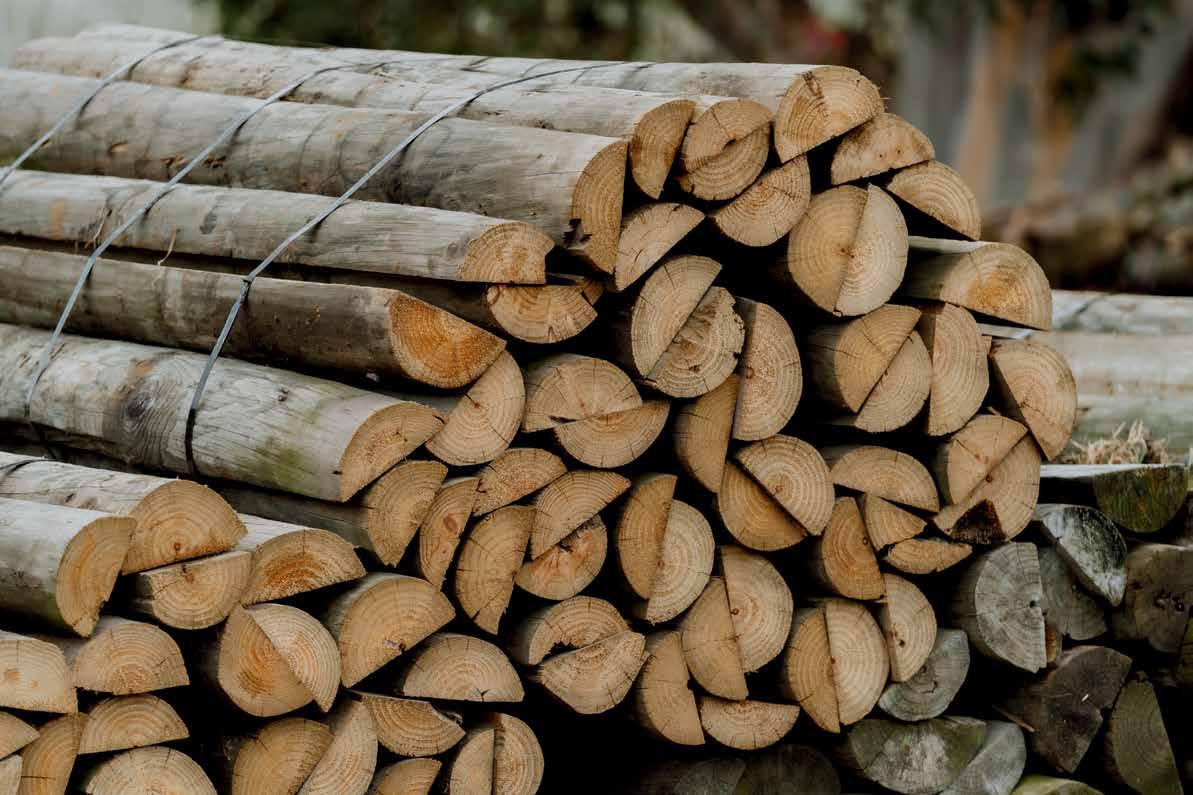
A RESEARCH programme supported by Beef+Lamb NZ is investigating the potential of ‘accelerometer’ sensors for early detection of conditions such as facial eczema (FE) in sheep.
Accelerometers can gather data through measuring the movement or acceleration of an object. They feature in many everyday devices such as smartphones for providing step counts.
In farming, they can be used to monitor behaviour of livestock to inform management decisions around welfare and production efficiency. Actions such as head shaking or avoiding sunlight may be indicators of FE.
The B+LNZ project, jointly led by senior AgResearch scientist Dr Karin Schutz, investigated the use of accelerometers fitted to a collar
to predict the behaviour of sheep. It established that the collars with sensors attached are simple and effective to use with sheep. Data gathered is now being analysed, including identifying findings which could be used to predict early signs of disease or injury.
“Technology such as accelerometers allow for data from a large number of animals to be obtained continuously, 24/7, without the presence of humans,” says Schutz.
“It is relatively cheap compared to using humans to observe the animals or setting up video equipment. This makes the technology particularly attractive for extensively managed livestock which can be studied under normal management conditions.”
He says behaviours such as grazing, ruminating and resting are the

main behaviours of sheep on pasture. Monitoring changes in daily behaviour patterns across the annual production cycle, while capturing changes in environmental conditions, can reveal key metrics that can be used to improve welfare and production efficiency on farm.
“These same metrics could possibly provide early warning systems for significant issues such as facial eczema, lameness
and gastrointestinal parasites.
“By developing tools for early detection, farmers can reduce economic losses and enhance productivity and welfare through timely interventions and improved management practices.”
Dr Mhairi Sutherland, B+LNZ’s senior scientist animal health and welfare, says research like this is exciting as it could be a step towards providing a practical tool for
farmers to manage disease risk.
“Facial eczema is a serious issue for livestock farmers, particularly in warmer and more humid regions. Having a way to detect the early signs of the disease before visible signs appear could make a significant difference in mitigating its impacts,” she says.
She adds that new technologies such as accelerometers could complement other on-
farm disease management approaches. “By integrating this data with other risk factors such as spore counts and weather conditions, farmers could take proactive measures to reduce the risk of outbreaks and improve overall animal health.”
The sensors were fitted to the sheep using collars developed by Bryan Thompson, a PhD student at AgResearch’s Invermay campus.
The research project was done in November 2024 at the AgResearch farm in Hamilton with a group of mixed aged Romney type ewes. The collars feature 23mm wide webbing and buckles and weigh 230-250g.
Alternative ways to fit accelerometers to livestock include halters, harnesses or ear tags. However, Schutz says the research established that the collars are effective
and practical to use on sheep over an extended period without causing irritation, getting caught in anything or being torn off.
“They can be put on the animals in the yards quickly and easily with minimal stress and the sheep adapted quickly,” says Schutz.
“We didn’t want anything around the animals’ faces as we are also looking at predicting shortterm behaviours that may be associated with FE which often affects the head of the animals.”
The next phase of the programme will be funded through the Eliminating Facial Eczema Impacts (EFEI) programme, a partnership between B+LNZ and the Ministry for Primary industries through the Sustainable Food and Fibre Futures (SFFF) fund.



DANIEL
CLAAS HAS recently celebrated the 250,000th CLAAS mower – a Disco 3200 FC – rolling off the production line in Bad Saulgau, south-west Germany.
Front mowers play a key role in boosting the productivity and quality of forage harvesting, says Dirk Röhrich, global product team manager Greenline.
“Our mowers have evolved from a simple side-mounted mower to the front-rear mower combination with or without conditioner, that virtually doubled the area mown, while reduc-

ing its first Disco butterfly mower in 1999.
Disco 1010 with working widths of up to 9.9m.
Last year, Direct Swather technology combined with a tapered swathing auger has enabled swath grouping to be performed without a conditioner, making it an efficient option for lighter four-cylinder tractors. MARK
ing the number of passes. The next step to a triple mower combination paved the way for enormous increases in quality and productivity.”
The current Claas Disco product range comprises of around forty different models with working widths from 2.2 to 10.7m.
Since 1996, Disco disc mowers have encompassed innovations like the Max Cut mower bed with its wave-shaped profile, the hydro-pneumatic
Active Float suspension or vector folding. Starting out initially with a working width of 2.6m, Claas were quick to respond to growing demands, unveil-
THE RECENT East Coast Farming Expo, held over two days at Wairoa, offered an insight into the current state of agriculture on the east of the North Island, at a time when the locals are remembering the second anniversary of Cyclone Gabrielle.
Despite much of the infrastructure around roads and bridges still underway, or in some cases, put in the “too hard” basket, locals were attending the event with a great deal of positivity, particularly as dairy, beef and sheep prices were now in ascendency.
While the Expo was a chance to see the latest machinery and tech for agriculture, or a chance to quiz industry advisors, it also offered a chance to catch up with old friends for a chat and a cold drink.
A packed seminar marquee tackled the issues of the day, with a range of speakers on day one including Dr John Roche, chief scientific officer

for MPI, discussing emerging genetic technologies, while Cara Brosnahan, the principal scientist for Animal Health Research at Beef + Lamb NZ looking at facial eczema and on-farm parasites.
Day two quickly hit the 30-degree mark on the thermometer by midmorning, with a large crowd learning
about drench resistance, followed by the topic of “Wild About Wool” with panellists discussing how to add value to a crop that continuously seems to sit in the doldrums. The speakers included John McWhirter, CE of Wools of NZ, Dan Norman of Big Save Furniture and National Fieldays Innovation Awards winner Maddie Foote



Meanwhile, at Agritechnica 2005, it showcased the Cougar self-propelled mower with a working width of 14m – the widest and most powerful mower on the market at the time. In 2007, the vertical 90-degree transport folding previously used in rear mowers was superseded by the 120degree transport position with the centre of gravity shifted inwards. Since 2021, diagonal vector folding in the Disco 4400 has enabled safe, legal road transport for working widths of 4.2m, an innovation which was extended in 2021 to the
from Iona College, who built a clever wool cladded study pod.
The biggest buzz during the second day was the Rural News Cadet Challenge, fought out by eight teams of three from schools and colleges throughout the Hawke’s Bay and East Coast.
Arriving without any pre-warning what their challenge entailed, the teenagers watched a demonstration of how to bone a leg of lamb by Vaughan McNabb from Affco, followed by rural butcher Taiamai Corker mincing the meat to make sausages using natural skins.
Given 90 minutes to complete the task, the teams were also presented with a table of herbs, spices and flavourings to tempt the tastebuds, when blended with the sheep mince to create the “perfect” snarler. They were tasked to produce an accompanying side dish, with salads, citrus
For more than 15 years, Disco large-scale mowers have been available with Auto Swather swath grouping with cross conveyors, with 2023 seeing the launch of the flagship Disco 9700 RC Auto Swather with roller conditioner for highly productive biomass crops yielding over 60 t/ha.
and, of course, the staple East Coast ingredient sweetcorn, both dishes to be presented for tasting to three esteemed judges. Certainly a hive of activity for the 90 minutes, with a few “oh bugger” moments and some “interesting” flavours presented, a close battle saw the young ladies of Woodford House School in Havelock North take the overall honours. Their prize included the Competition and Individual trophies, accompanied by a plain envelope, which we understand held a substantial cash reward.
The winners, Hannah Newman, Sophie Storrar and Chloe Williams, would certainly have a big smile on their faces on the arduous trip back west, alongside a better understanding that putting some good sausages on the dinner table is not just about a dash into a New World or Pak’n’Save store! – Mark Daniel







TAKING PRIDE of place at Central Districts Field Days, the new 600 Series was Fendt’s incarnation of a compact and manoeuvrable 4-cylinder tractor in the 150-200hp sector.
Offered in four models, the 614, 616, 618 and 620 deliver 149 - 209hp, with for the first time Dynamic Performance, releasing up to 15 additional horsepower based on demand, to push those numbers to 164 – 224hp, with maximum torque values from 793 to 950Nm.
Product manager AU &NZ, David Hillan, says the DP concept is not linked to driving speed or PTO shaft deflection, rather it functions dynamically based on demand, even when carrying out stationary PTO work, or depending on conditions, during tillage operations.
At the heart of the tractor, the recently developed 4-cylinder, 5-litre AgcoPower Core 50 engine meets emission requirements via DOC, DPF and SCR, without

exhaust gas recirculation.
As with its larger siblings, much of the design of the new 600 Series centres around a “high torque, low engine speed” concept, with a rated speed of 1,900rpm and a main working range of 1,350 to 1,800rpm.
The transmission,
a single stage system, eliminates the need for manual range shifting when changing from paddock to transport duties, while featuring the Fendt VarioDrive concept, which delivers independent control of the front and rear axles. In operation, the system con-
stantly measures slip at each of the wheels and regulates power distribution, meaning a tension-free driveline. This dynamic control helps prevent wheel-slip, resulting in maximum traction, irrespective of the underlying surface.
An additional feature
of the drive layout is the “pull-in turn” effect created by the independently driven axles, resulting in a much tighter turning circle of only 10.2 metres when fitted with 54565R30 tyre equipment.
With a power to weight ration of around 34.4kg per horsepower,
while offering a gross vehicle weight of 13.5 tonnes, a tare weight of 7,700kg and potential payload of 5.8 tonnes, the 600 series is a versatile offering with a light footprint, but also capable of heavy towing duties.
At the business end of the tractor, a lift capacity of nearly 10 tonnes is complemented by a 152l/ min or 205l/min hydraulic pump, with closed centre/ load sensing, Power
Beyond and a maximum hydraulic oil take-out of 65 litres, meaning the largest trailers, equipped with multi-stage rams are tipped easily. Working alongside a 4-speed PTO system, depending on specification, up to 10 double-acting remotes can be specified, with front, central and rear locations.
Elsewhere, optional features include VarioGrip, for “on-the-go” inflation and deflation of tyres for reduced ground pressure or high-speed travel, while the cabin offers allround and upwards visibility, with the option of a CAT 4 filtration system against dust and chemicals on the VisioPlus version.
WHILE THE German tractor market for 2024 saw a fall of 3.4% in tractor sales to 29,291 units, Fendt bucked the trend with an increase of 20% or 1,281 extra units giving it 25.2% of the market.
Fendt was dominant with its 700 Vario Gen7 series the most popular tractor model in Germany in 2024, with more than 1,500 units of the 728 Varios registered, while the 724 Vario sold more than 1,000 units.
John Deere took second place with a 15.9% share, while third place went to Claas at 7.6%, followed by Deutz Fahr in fourth and Kubota rounding out the top five. Overall, Agco brands secured exactly one-third of the market, around twice that of its nearest rival, John Deere. CNH achieved 10.7% with Case, Steyr, and New Holland combined.
FRONT END loader and implement specialist Quicke has introduced the new Unigrip L+ and XL+ next-generation bale grabs, designed for users who need strength, efficiency, and soft handling in their daily tasks.
“We set out to create a bale grab that gives you both robustness and efficiency,” said Henrik Jöns-son, product manager implements at Quicke.
“This includes reinforced stress points and an adjustable back bale support, alongside other subtle design details to help get more work done, without compromising on bale quality.”
Fitted with an adjustable back support, with the option for a second assembly, the Unigrip L+ and XL+ allows users to grab and transport two bales at once, doubling productivity in the paddock.

Suitable for handling silage, hay, or straw, the L+ version can handle bales from 120 to 160cm, while the XL+ version can handle bales up to 190cm.
The manufacturer notes that one of the key features of the Unigrip L+ is its ability to handle bales softly while ensuring they are securely
held in place, meaning bales can be transported without damaging or compressing them, so preserving the quality of silage, hay and straw
at all times.
Fitted with the optional equalizer bar, synchronized arm movement gives it the same features as a twocylinder bale grab.
Unigrip L+ and XL+ are equipped as standard with a pressure restrictor valve to protect the silage from compression, alongside preventing structural damages to the implement’s basic components.
Additionally, a load-hold valve for handlers with free return to tank on third service is offered to ensure a secure grip.
Unigrip L+ and XL+ are compatible with most agricultural loaders and handlers, while in early 2026, Quicke will launch the smaller S+ and M+ versions, completing the full Unigrip family to meet all round bale handling needs. – Mark Daniel @rural_news facebook.com/ruralnews







